Making for the future
Advanced manufacturing at Imperial
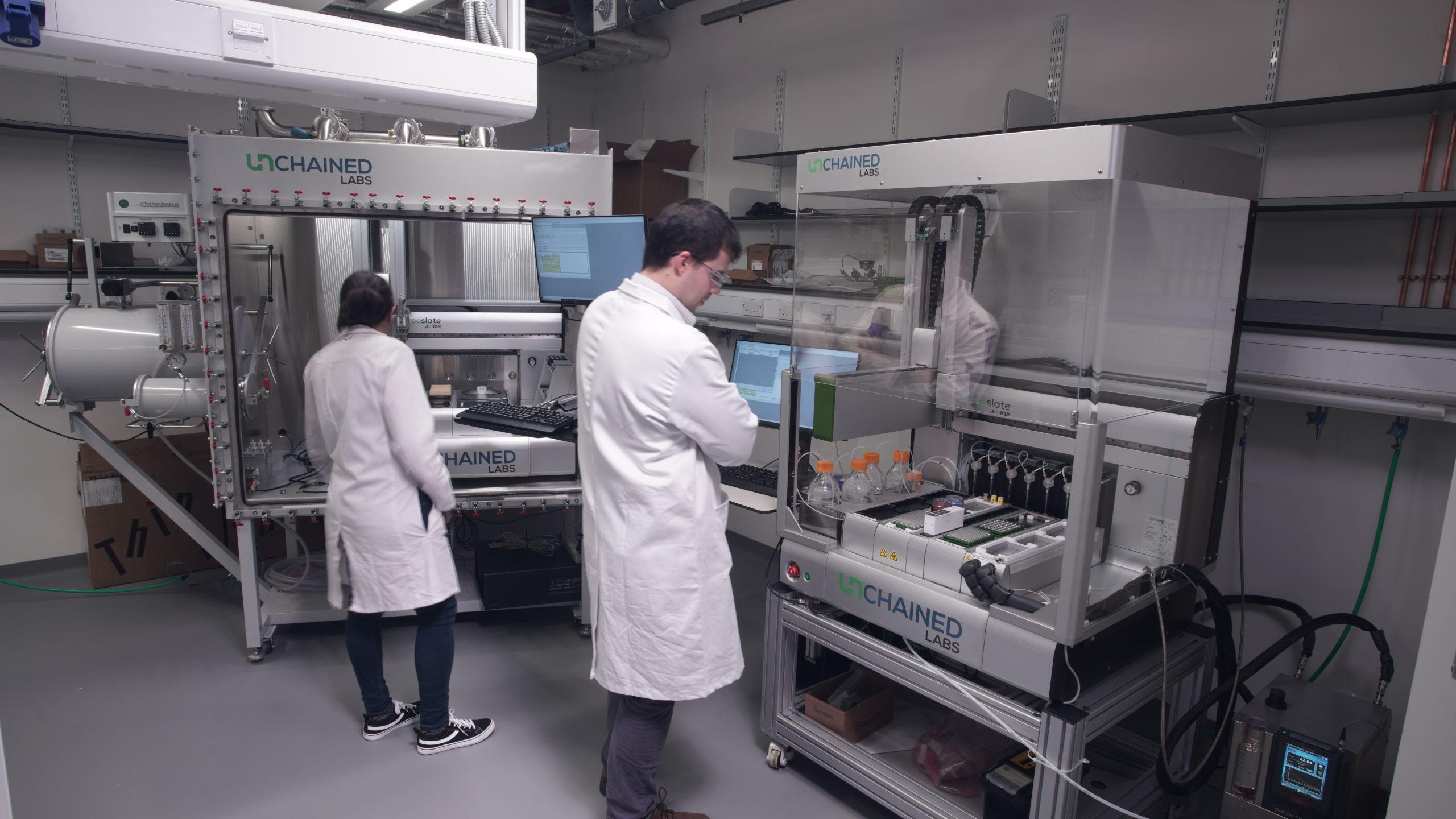
Manufacturing practice evolves naturally within companies, but to make a significant leap forward you need new knowledge and new ways of thinking.
“You can't always anticipate where the breakthrough or the bottleneck will be,” says Professor Nilay Shah, head of Imperial's Department of Chemical Engineering. “Quite often, it's not directly in the manufacturing research, but in fundamental research. It could be in maths, physics, chemistry, computing, or aspects of engineering.”
This makes Imperial a natural home for advanced manufacturing. “Our strength is the breadth and depth of our fundamental research into science, engineering, and to a certain extent in medicine, which can then make its way into manufacturing innovations.”

Professor Nilay Shah, head of the Department of Chemical Engineering
Professor Nilay Shah, head of the Department of Chemical Engineering
For that happen, two kinds of connection are necessary. The first is between fundamental research and its application. “The best channel for that is industrial collaboration, and we have more industrial collaborations than any other university in the UK,” says Professor Shah. “That means we can work with companies to embed these developments into new technologies.”
The second kind of connection is between disciplines, so that people with complementary knowledge can find and inspire each other. This is achieved within networks that cross Imperial's departments and faculties, such as the Manufacturing Futures Lab. “This brings together a community of people who are interested in manufacturing, either because they are already engaged in it, or because they realise their skills and capabilities are highly relevant for manufacturing.”
New platforms for vaccine manufacturing
In Professor Shah's case, the Lab provided a space to discuss new platforms for vaccine manufacturing with engineers, life scientists and medical researchers. “It's the kind of conversation where two people both have problems in different domains, and they realise that they can help each other. And that sparks some interesting new ideas.”
As a result of these discussions, Imperial was ready to respond when the UK government announced plans to create a hub for vaccine manufacturing technologies. “Now we have £10 million in funding and a big research programme in vaccines manufacturing, which looks like it is going to deliver two or three new vaccine manufacturing platforms, and demonstrate those in countries around the world.”
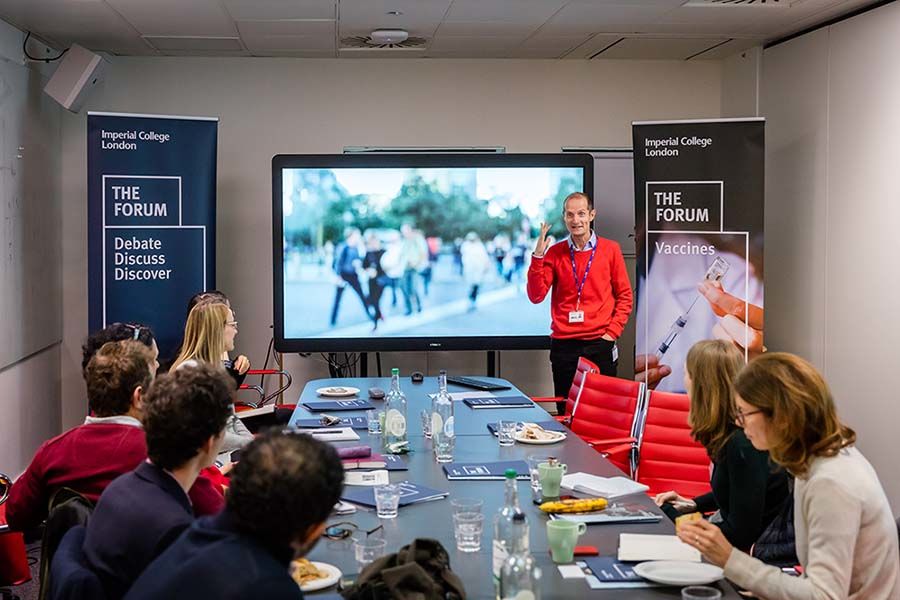
Professor Robin Shattock, lead investigator of the Future Vaccine Manufacturing Hub, talks to policymakers at The Forum, February 2019
Professor Robin Shattock, lead investigator of the Future Vaccine Manufacturing Hub, talks to policymakers at The Forum, February 2019
The aim is to help tropical countries respond rapidly to disease outbreaks. “We are developing modelling and other computational methods to produce design blueprints that we can then show to our partners in Africa and Asia,” Professor Shah explains. These would tell them the equipment and materials they will need, how to put them together and get the process working, how much vaccine it will produce and the predicted cost per dose.
“We are starting to produce some new vaccines, in small quantities,” he goes on. “The next step is to produce them at slightly larger scale, and test how well they perform compared to conventional vaccines.”
A digital leap for synthetic chemistry
Digital methods have also been instrumental in advancing synthetic chemistry. “It's about turning chemical synthesis into a data-led subject,” says Professor Mimi Hii, who directs the Centre for Rapid Online Analysis of Reactions (ROAR) at Imperial's White City campus. This is a new national facility that includes systems for chemical synthesis, reaction analysis, laboratory automation and optimisation, and – of course – data analysis.
By drawing together data on all known chemical reactions, and making smart predictions about untried pathways and combinations, these systems should make it possible to digitally 'dial up' any molecule that needs to be manufactured. “If we do it right, this should lead to faster discovery, where we don't waste so much of our time in trial and error. At the same time, through automation and automatic data collection, we can eliminate human error and human biases.”
One early project for ROAR has been a partnership with South Africa, supported by the UK government's Global Challenges Research Fund, looking at ways to make the country's pharmaceutical industry less reliant on imported drugs and chemical components. The first target was a breast cancer drug, which is both expensive and in high demand. “We set out to devise a manufacturing route that was cost effective, environmentally sustainable, and worked with the resources available in South Africa,” Professor Hii explains. “Using the resources in ROAR, we came up with a new synthetic route within three months. Normally that might have taken many more months or even years.”
There are also plans underway to establish a Centre for Doctoral Training in synthetic chemistry alongside ROAR. Instead of learning traditional synthetic skills, PhD students will cover subjects such as data analysis, automated systems, and how to operate the new generation of continuous flow reactors capable of on-demand synthesis. “Over five years, we will train at least 60 people, with more studentships to come, because the industrial interest is still growing.”
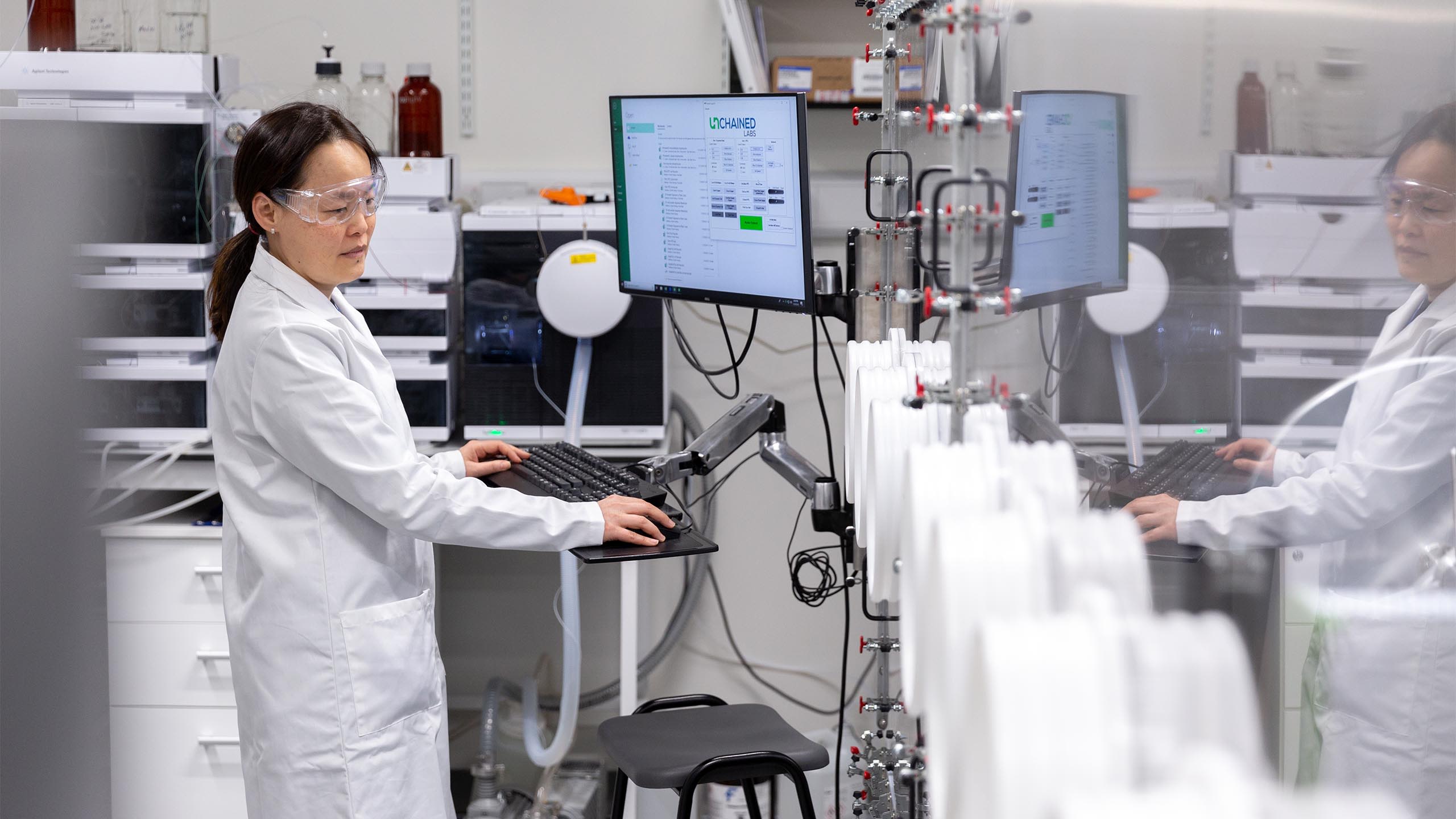
Professor Mimi Hii, Director of the Centre for Rapid Online Analysis of Reactions (ROAR), uses the new White City facility.
Professor Mimi Hii, Director of the Centre for Rapid Online Analysis of Reactions (ROAR), uses the new White City facility.
Forward thinking in gene therapy
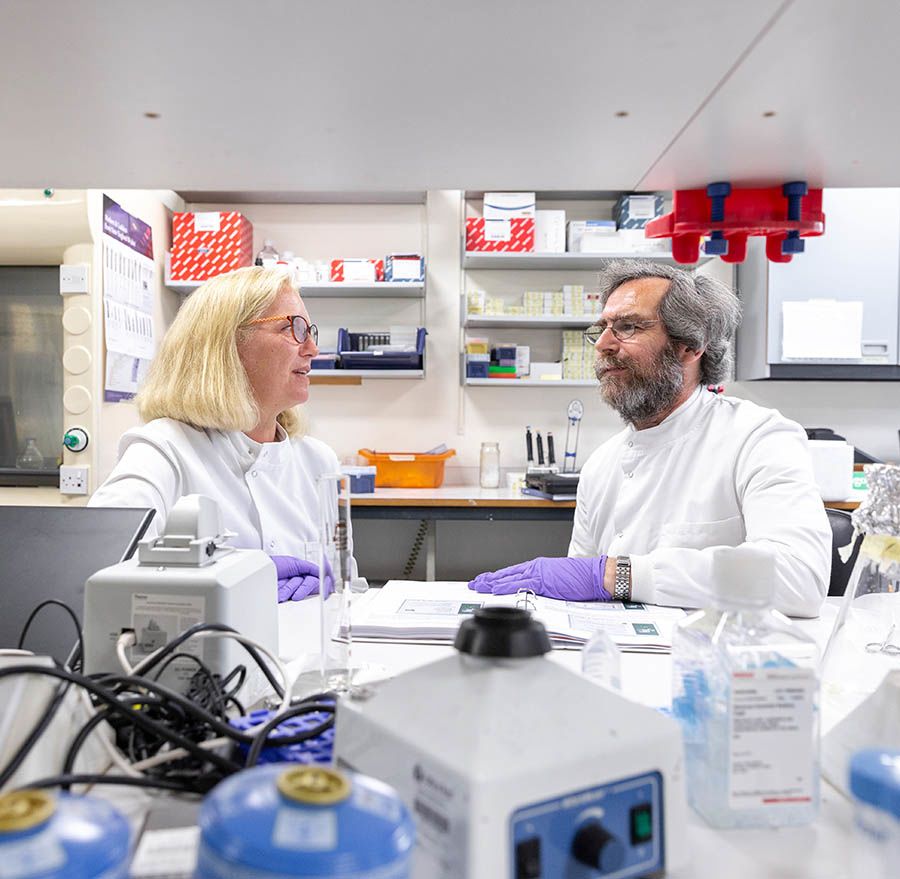
Professors Uta Griesenbach and Eric Alton, who are working to develop gene therapies that can be manufactured at commercial scale at the National Heart & Lung Institute
Professors Uta Griesenbach and Eric Alton, who are working to develop gene therapies that can be manufactured at commercial scale at the National Heart & Lung Institute
Manufacturing is an early consideration in the gene therapy research carried out by Professors Uta Griesenbach and Eric Alton, at the National Heart and Lung Institute. This forward thinking ensures that the transition to clinical trials and beyond runs smoothly.
They are working on cystic fibrosis and other rare genetic lung diseases. Gene therapy aims to treat these diseases by supplying a functioning gene, and one way of doing that is by using a modified virus as a carrier, or vector, to take the replacement gene to the appropriate cells.
“At the moment we are preparing for a clinical trial with a viral vector: a lentivirus,” Professor Griesenbach explains. “We are manufacturing this vector in-house for the pre-clinical work, which is just small-scale, but we are working with Oxford BioMedica and Boehringer Ingelheim to manufacture the clinical-grade material.”
Treating an organ as large as the lung in a clinical trial already means scaling-up production to a significant degree. But it also pays to think early about the implications for production of the drug at a commercial scale, after it is licensed.
“If you do an early phase clinical trial with a vector made using an early development process, and swap to a more advanced manufacturing process later, the regulatory bodies may have a view,” she says. “If you don't show comparability between the different processes, then you may have to re-do some of your early phase clinical trials. It therefore pays to think about manufacturing processes early on in a translational research programme.”
Optimising manufacturing protocols to increase the amount of vector produced is also an important goal. “Working with Oxford BioMedica, a world leader in lentivirus manufacturing, we can stand on their shoulders and don’t have to start from scratch. However, the steps that are unique to our virus are part of the downstream processing, the purification and activation of the virus, and these new steps have to be optimised and validated.”
Algorithms for optimal chemical processing
Dr Ruth Misener started out as a chemical engineer, then switched to computing in order to work on new optimisation methods in oil refineries and petrochemical plants. “I'm solving problems that come up in chemical engineering, but we are doing it by making fundamental contributions to computer science.”
Her team in the Department of Computing is particularly interested in common problems that remain challenging to solve. “If it is something that only comes up once or twice, it is not worth our time.”
One fruitful subject is scheduling, where tasks need to take place in a set order, within a set time. “That can get very complicated indeed on a petrochemical refinery, for instance. What we do is select the aspects that are theoretically or computationally difficult to handle, and develop mathematical strategies and algorithms that take care of that part of the problem.”
To do this she can draw on advanced techniques that were not available just a decade ago. “We have a lot of new methods in mixed integer nonlinear optimisation, which give us algorithms able to solve problems that are ten times bigger than before,” she explains. Developments in machine learning are also proving useful. “My team collaborates with machine learning researchers at Imperial to integrate the kind of models they create into our optimisation systems.”

Dr Ruth Misener, Senior Lecturer in the Computational Optimisation Group, Department of Computing
Dr Ruth Misener, Senior Lecturer in the Computational Optimisation Group, Department of Computing
Optimising systems for uncertain conditions has also come a long way. “We try to understand, within the algorithm, that things are going to go wrong, and respond actively to that kind of situation.” For example, if a machine breaks down or a reagent fails to arrive at the right time the aim might be to recover quickly, but also to limit disruption by minimising the number of changes that have to be made. “The problem that you have to solve is different. There are extra restrictions that you want to include so that the process has good recovery properties.”
While originating in the chemicals sector, these optimisation solutions can have a much wider application. The work on scheduling, for instance, resulted in a collaboration with Royal Mail. “Delivering mail also requires scheduling jobs onto machines,” Dr Misener says.
She has also benefited from connections made through Imperial's networks, in particular the Centre for Process Systems Engineering. “The Centre's industrial consortium is where I can workshop new ideas, and show industry what I'm working on,” she says.
The same kinds of connection are also possible through initiatives such as the Energy Futures Lab and the Data Science Institute. “These involve different people from different places, so you get to meet lots of like-minded industrial colleagues.”
3D printing for engineering applications
One of the newer networks at Imperial is the Additive Manufacturing Network, set up by Dr Billy Wu and Dr Connor Myant in the Dyson School of Design Engineering to look into strategies for exploiting 3D printing and related technologies. “To do that you need people with different expertise – designers, engineers and scientists – to come together, and Imperial is a unique place that allows us to achieve that,” says Dr Wu.
Applying these technologies to manufacturing is a work in progress. “3D printing with plastic is great for low-cost manufacturing, but when you want to get to engineering applications you need the robust mechanical properties of metals.” So Dr Wu is working with direct metal laser sintering, in which a high-powered laser builds an object by fusing layers of metallic powder. “We do that layer by layer, just like making a loaf of bread slice by slice.”
Being able to print in metal opens up possibilities for more agile manufacturing. “Traditionally, the way you make a chemical reactor, for example, means locking in a design that is optimised for certain conditions. With 3D printing we can rapidly produce different reactor designs that respond to these changes.” One application for this is in the chemical processing industry, where reactor design might be varied to optimise a certain chemical reaction.
A similar design lock occurs with injection moulded plastics, where the master moulds are time-consuming and expensive to produce by conventional methods. “With 3D printing we can manufacture a new mould overnight. So we get the low-cost advantage of injection moulding, with the responsiveness of 3D printing.”
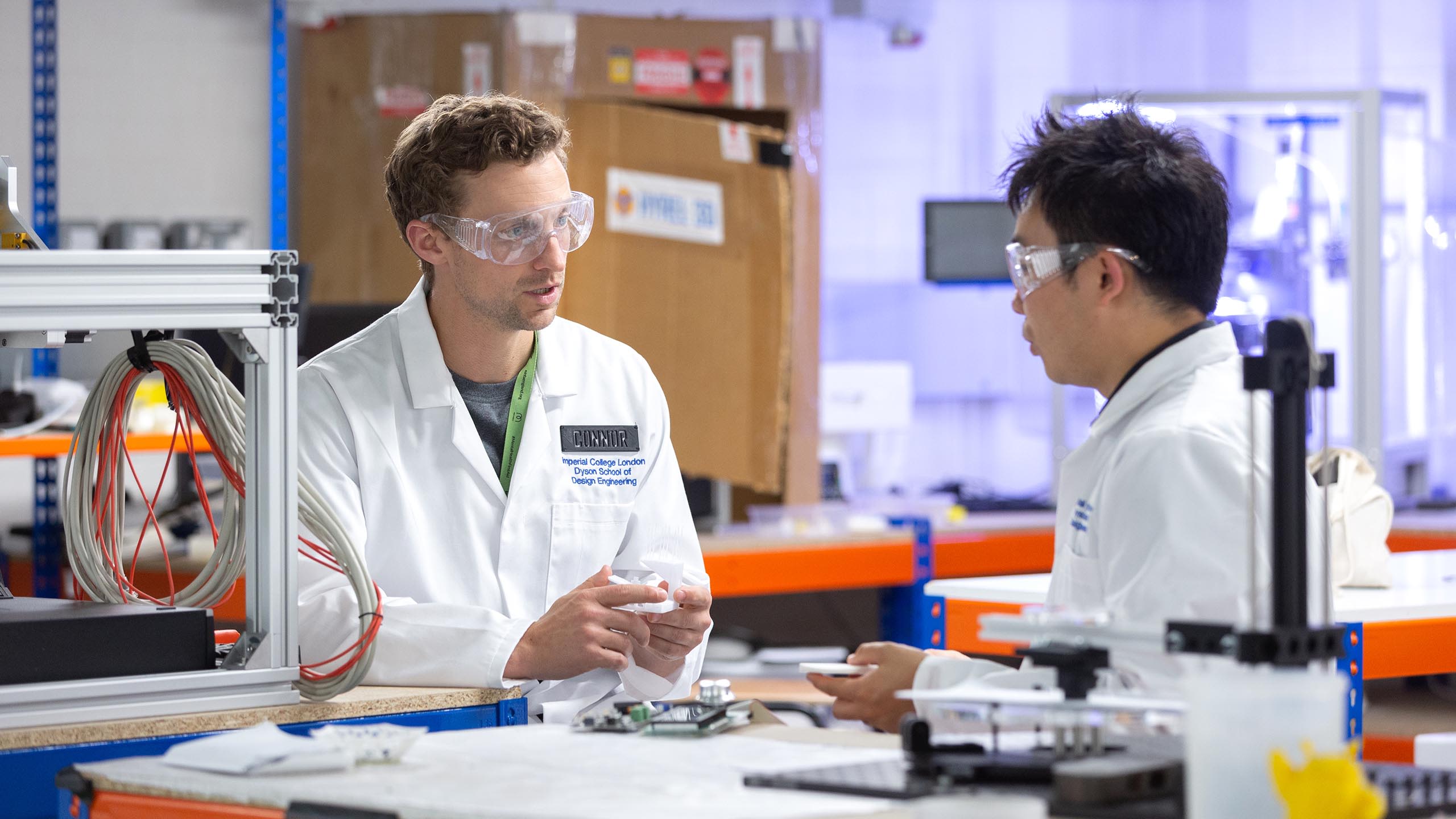
Dr Connor Myant and Dr Billy Wu, lecturers in the Dyson School of Design Engineering and co-directors of Imperial's Additive Manufacturing Network
Dr Connor Myant and Dr Billy Wu, lecturers in the Dyson School of Design Engineering and co-directors of Imperial's Additive Manufacturing Network
Novel reactors for fuel cells
Metal 3D printing can also make novel structures, a capability Dr Wu is exploring in connection with fuel cells, for applications ranging from cars to drones. Fuel cells typically operate by combining hydrogen and oxygen from the air to generate electricity, with the only by-product being water. Conventional fuel cell designs use plates with winding, snake-like channels that the reactants flow through to reach the reaction site. However, this design has limited efficiency when operated at high powers, due to difficulties in getting the gas through the channels.
So Dr Wu and his colleagues looked to the human body for inspiration. “We've designed a fractal-based fuel cell, where the serpentine flow channels have been replaced with a structure that takes the efficient gas transfer principles of the human lung to achieve much higher performance,” he says. “Given the complexity of this geometry, it could only be manufactured with 3D printing.”
Meanwhile Dr Wu is also working on a more economic approach to 3D metal printing, based on electroplating. He has replaced the plastic extruder in a conventional 3D printer with a syringe filled with a metal depositing solution. When a current is applied to an electrode immersed in this solution with a bead of fluid at its tip, and brought into contact with a surface, the device lays down a precise layer of metal.
“That allows us to create a metal 3D printer at a very low cost,” he says of the method, which is still in the early stages of development. It also opens up new possibilities, such as the ability to print layers of different metals, and – when the current is reversed – to recover and recycle previously printed metals.
New life for traditional manufacturing methods
While 3D printing offers a radical new approach to manufacturing, it is also possible for new knowledge to enhance the capabilities of older methods, such as metal casting, forming and machining. “With computer control, the integration of artificial intelligence, and our knowledge of materials, mechanics and processes, these traditional technologies can be used more efficiently to manufacture components that meet current demands,” says Professor Jianguo Lin, from the Department of Mechanical Engineering.
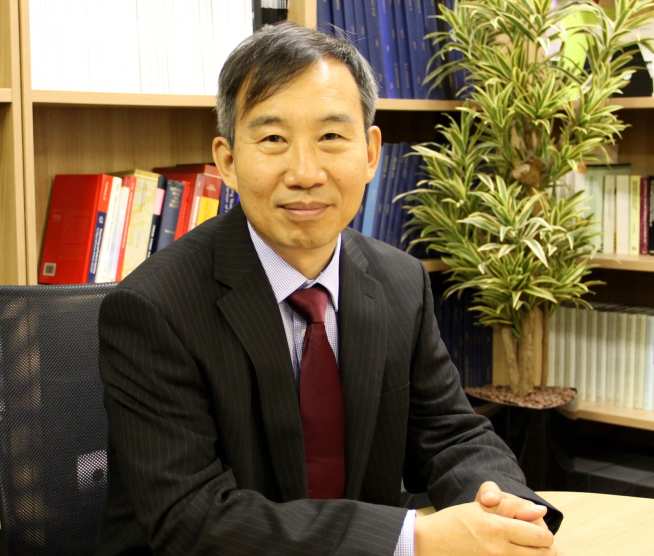
Professor Jianguo Lin in the Department of Mechanical Engineering. Professor Lin is theme lead for innovative production processes in Imperial's Manufacturing Futures lab, and works extensively with industry.
Professor Jianguo Lin in the Department of Mechanical Engineering. Professor Lin is theme lead for innovative production processes in Imperial's Manufacturing Futures lab, and works extensively with industry.
For example, 80–90% of car body structural components are manufactured using forming technologies. If cars can be made lighter they will become more fuel efficient and produce less carbon dioxide. The same shift to lighter bodies would also help produce electric cars with a much greater range. However the light alloys such as aluminium, magnesium and titanium alloys that could achieve this are very difficult to shape.
While a component with complex shape, such as a car door inner, can be made from one piece of steel, making it from aluminium alloy might involve laser welding together five separate panels. “This is expensive and the structural integrity is not very good.”
So Professor Lin and his colleagues came up with a way of combining the heat treatment required to produce a highstrength aluminium alloy with the metal forming operation, so that a door inner could be produced in one part, reducing the cost significantly.
The same approach can also be used with magnesium alloys, which are even lighter. “This is possible because we have a further understanding of the materials science and mechanical behaviour of these alloys.”
Professor Lin has also benefited from working within Imperial's Manufacturing Futures Lab. “Nowadays the integration of technologies is very important, so we need to encourage people to communicate. For example, a lot of people work on robotics and control, and these are very important for mass production in manufacturing processes.”
Robots for higher productivity
One of the people at Imperial who is rethinking robotics is Dr Nicolas Rojas, also in the Dyson School of Design Engineering. His work is shaped by fundamental questions about how robots are designed and operate, but also by the challenges faced by industry.
“One of the current needs, particularly in the UK, is to increase the productivity of small and medium sized manufacturers. The problem is that they tend to be producing multiple, high-quality products, but in small batches. To do that you need humans, but if all you have is humans, then it's impossible to improve productivity.”
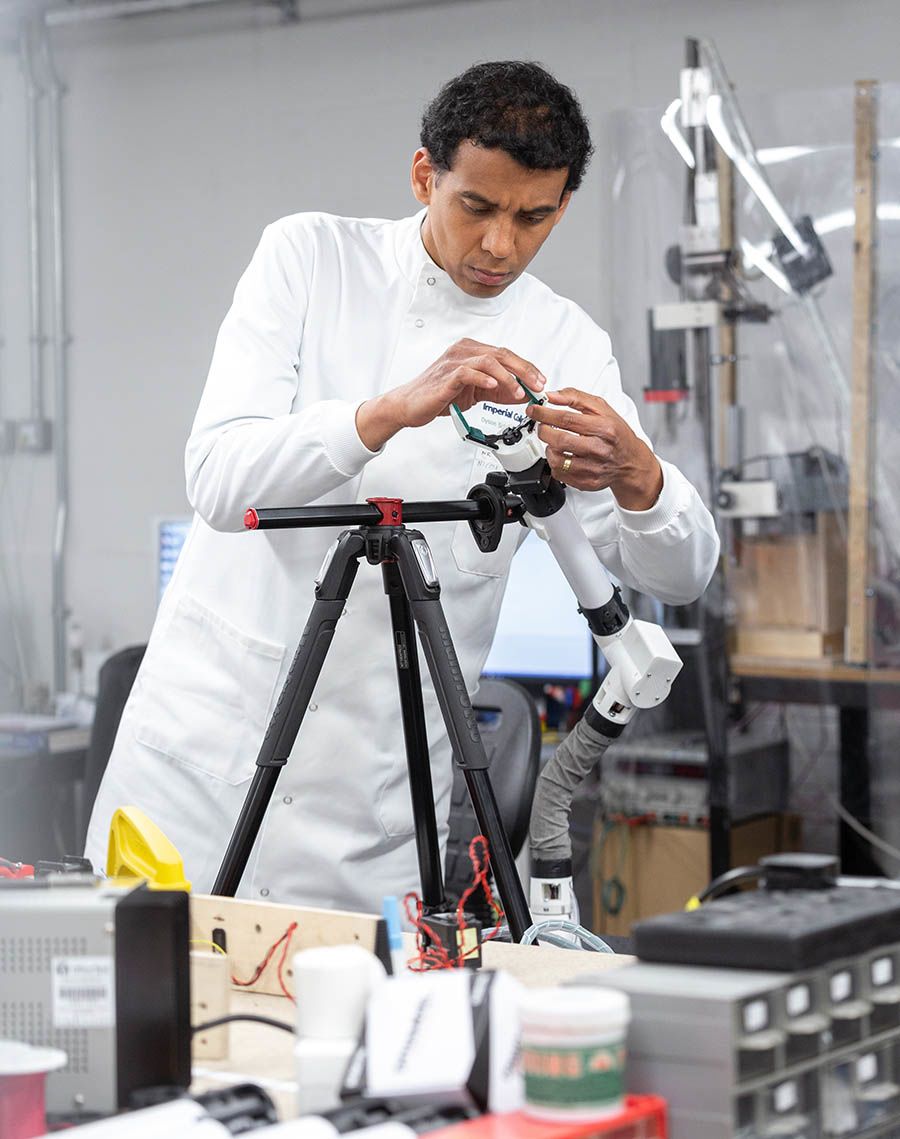
Dr Nicolas Rojas, who leads the REDS Lab in the Dyson School of Design Engineering.
Dr Nicolas Rojas, who leads the REDS Lab in the Dyson School of Design Engineering.
Robots that work with humans – known as cobots – offer one way forward, although their potential has yet to be fully realised. One problem is that many cobots are over-specified and so take up a lot of space on the factory floor. “The idea is that you need these very big robots, with many motors and degrees of freedom, because you need flexibility. So we are working on robot arms with a minimum number of motors, but the same dexterity.”
Another goal is to produce malleable robots, which a human operator can reshape to perform different tasks. “Robot arms are generally inspired by our arms. But imagine you had a forearm that is not constant, that you can reshape,” Dr Rojas says. “We are developing a variable stiffness limb that becomes very flexible when the user want to reshape it, and then becomes rigid once the system is activated.”
This might be used, for example, to optimise a cobot's speed. “We know that some morphologies of robot arms are faster than others for some operations, so we are designing technology that can be shaped according to the task.”
Another line of thought moves even further from anthropomorphic robot arms to look at parallel robots, with multiple arms that connect to move single gripper or robot hand. “The payload capacity of these robots is very high, and they can move very fast,” says Dr Rojas. However, the design introduces constraints that still need to be overcome for high adaptability. “So we are developing a very dextrous, parallel robot with a large workspace that can be used for pick-up and place operations.”
Bringing advanced manufacturing to the market
Behind all of these developments is Imperial's strategy for bringing advanced manufacturing to the market. One aspect of this is an ambition to do even more translational work. “This is where the new White City campus will be useful, to look at scaling-up and translating some of the more fundamental work we are doing,” says Professor Shah.
One way this will be achieved is by setting aside co-location space on the campus. “This will be space where we can work together with collaborators, particularly industrial companies, to take some of the basic concepts and translate them into real technologies.”
There have also been changes in technology transfer support across the College, with the result that it is now provided entirely in-house. “That allows us to have a seamless system within the College,” Professor Shah says. “When we start work setting up research projects, we can already think about how some of the outcomes will be translated and which companies we will work with.”
Ian Mundell is a journalist who specialises in research and higher education. He divides his time between London and Brussels.
This Imperial Story was commissioned by the College's Enterprise Division.
The Division helps businesses to address their challenges by accessing the College's resources, talent and expertise - and helps academics and students find new ways to turn their expertise into benefits for society.
